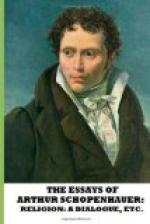And in regard to the study of physiognomy in general, it is further to be observed that intellectual capacity is much easier of discernment than moral character. The former naturally takes a much more outward direction, and expresses itself not only in the face and the play of feature, but also in the gait, down even to the very slightest movement. One could perhaps discriminate from behind between a blockhead, a fool and a man of genius. The blockhead would be discerned by the torpidity and sluggishness of all his movements: folly sets its mark upon every gesture, and so does intellect and a studious nature. Hence that remark of La Bruyere that there is nothing so slight, so simple or imperceptible but that our way of doing it enters in and betrays us: a fool neither comes nor goes, nor sits down, nor gets up, nor holds his tongue, nor moves about in the same way as an intelligent man. (And this is, be it observed by way of parenthesis, the explanation of that sure and certain instinct which, according to Helvetius, ordinary folk possess of discerning people of genius, and of getting out of their way.)
The chief reason for this is that, the larger and more developed the brain, and the thinner, in relation to it, the spine and nerves, the greater is the intellect; and not the intellect alone, but at the same time the mobility and pliancy of all the limbs; because the brain controls them more immediately and resolutely; so that everything hangs more upon a single thread, every movement of which gives a precise expression to its purpose.
This is analogous to, nay, is immediately connected with the fact that the higher an animal stands in the scale of development, the easier it becomes to kill it by wounding a single spot. Take, for example, batrachia: they are slow, cumbrous and sluggish in their movements; they are unintelligent, and, at the same time, extremely tenacious of life; the reason of which is that, with a very small brain, their spine and nerves are very thick. Now gait and movement of the arms are mainly functions of the brain; our limbs receive their motion and every little modification of it from the brain through the medium of the spine.
This is why conscious movements fatigue us: the sensation of fatigue, like that of pain, has its seat in the brain, not, as people commonly suppose, in the limbs themselves; hence motion induces sleep.
On the other hand those motions which are not excited by the brain, that is, the unconscious movements of organic life, of the heart, of the lungs, etc., go on in their course without producing fatigue. And as thought, equally with motion, is a function of the brain, the character of the brain’s activity is expressed equally in both, according to the constitution of the individual; stupid people move like lay-figures, while every joint of an intelligent man is eloquent.
But gesture and movement are not nearly so good an index of intellectual qualities as the face, the shape and size of the brain, the contraction and movement of the features, and above all the eye,—from the small, dull, dead-looking eye of a pig up through all gradations to the irradiating, flashing eyes of a genius.




